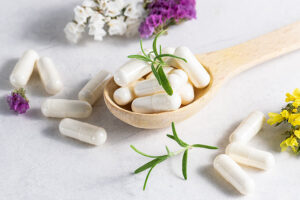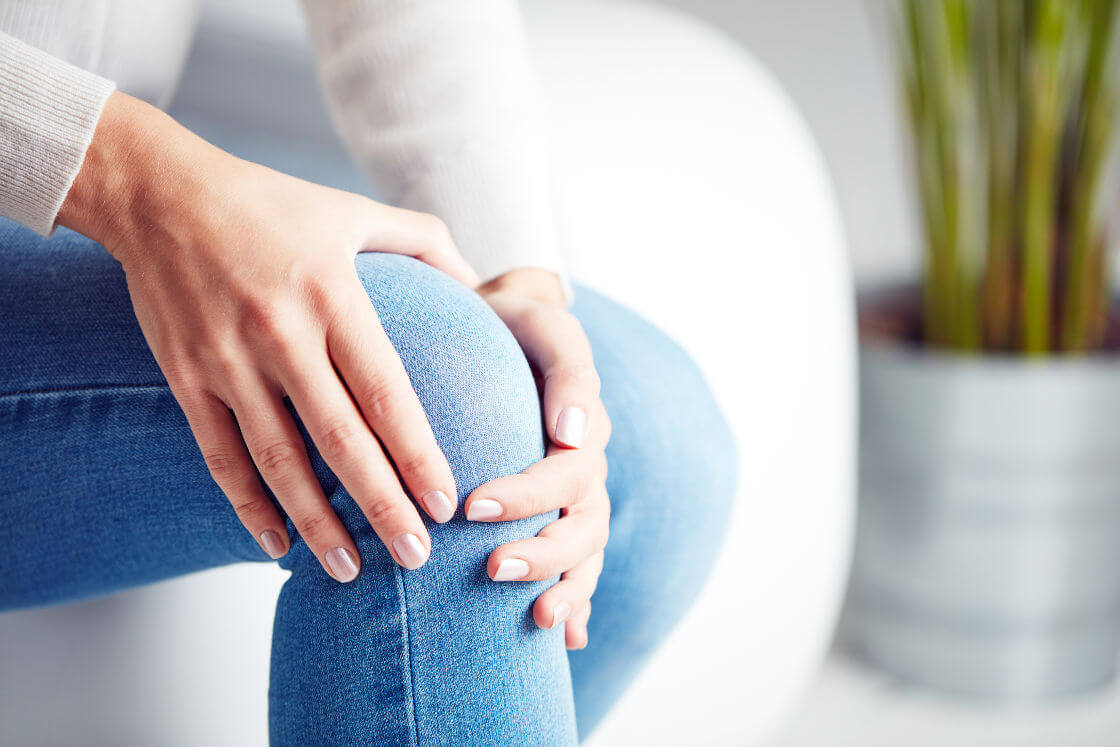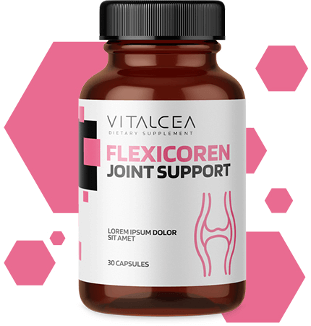

MOVING IS HEALTHY:
from A to Z about supplements supporting the joints
Joint problems affect millions of people around the world. It is one of the most common ailments, and at the same time one of the most underestimated. When you encounter joint pain, you can often hear that it just has to be this way, because the body is aging and its components wear out. But it’s not true that nothing can be done. Smart prevention is possible at any age, and its effectiveness brings measurable benefits to our health. Let’s get to know the ailments related to our joints and how to deal with them using, among others, exercise, diet and supplements.

If your joints hurt - you are not alone
Joint pain is a common condition that can result from both mechanical trauma and inflammation. It may disappear after a few days, but it often affects us for much longer and then it may be a symptom of the disease (e.g. systemic lupus erythematosus or RA, i.e. rheumatoid arthritis). It is important to seek treatment for such pain according to its cause.
Life passes us primarily through all forms of movement, walking, moving or exercising. You do not need to do competitive sports for a runner’s knee or a tennis elbow to catch us. Movement can negatively affect the hyaline cartilage, the connective tissue that covers the ends of bones. The degeneration of this cartilage can lead to arthritis and osteoarthritis, which is the most common form of inflammation in this part of the body.
According to studies in the United States alone, more than 30 million people suffer from this condition, and it is one of the leading causes of disability in American adults. The joints most commonly affected by osteoarthritis are the knees, hips, hands, feet, and spine.
What is joint pain and what are its types?
Arthralgia occurs regardless of age and gender, although statistically more often it affects women than men. It is the result of various abnormalities in the joint structures – tendons, bursa or ligaments. As with many diseases, people who are overweight or obese, and all “sandwiches” and “computer scientists” are particularly at risk. In a word, anyone who has forgotten that exercise is health. We divide joint pain into inflammatory, in which you can see swelling and redness, and non-inflammatory – without swelling, but with warmth and redness. It can be single-joint or polyarticular, as in the case of arthritis.
Why do joints hurt?
With painful joint ailments, we are able to quickly narrow down the search field, because the pain usually concerns a specific place. Most often it is associated with rheumatic diseases, injuries in the form of sprains and sprains, bacterial and viral infections, taking certain medications, cancer of the bones or cartilage, and inflammatory bowel diseases. In addition to the pain itself, there may be swelling, as well as redness and disturbed mobility. The following situations certainly require contact with a doctor:
- worsening of pain at night and consequent trouble sleeping,
- unusual additional symptoms, as well as weight loss, fever, general fatigue and muscle pain,
- limited joint mobility,
- problem with getting out of bed.
Supplements for articular cartilage without a prescription
Supplementation is an effective solution that can help regenerate damaged areas, thanks to which the return to their optimal functioning becomes faster. However, this does not mean postponing the visit to the orthopedist, because he should be the first to make a diagnosis and refer for treatment. Dietary supplements can also be used prophylactically. Most often they contain ingredients such as glucosamine, collagen, chondroitin, hyaluronic acid, as well as anti-inflammatory substances and vitamins. They are a good measure for both athletes and people who work physically and for the elderly.
Flexicoren works perfectly in this case, as it improves physical fitness and has anti-inflammatory properties, reducing pain in muscles and joints.
Meet our joint support product
When to introduce joint supplementation and who is it for?
It is worth taking care of the joints much earlier than the first problems, pain and discomfort. Our joints are exposed to many injuries. Even an improperly conducted warm-up can lead to them, not to mention a person who usually does not play sports, but on the spur of the moment suddenly starts intensive training without any preparation. A pond that has been damaged will regenerate over a long period of time. Each minor damage to the cartilage becomes covered with a scar, which is much weaker than the original tissue.
Therefore, it is worth taking care of an appropriate dose of physical activity first, which especially applies to overweight people whose excess kilograms burden their joints. Let’s not forget about a balanced diet – let’s try to provide our body with the necessary nutrients every day.
Do joint supplements work and how?
Supplements can make visible improvement faster if their ingredients are of good quality and at the right optimal concentration, as in the case of easily absorbed Flexicoren. Chondroitin contained in it is a mucopolysaccharide, which is one of the main components of articular cartilage. It takes part in the production of proteoglycans, thanks to which extracellular plaque is formed, which protects the joints against the harmful effects of external factors. Chondroitin has a regenerating, protective and analgesic effect, and is most effective when combined with glucosamine. It is also an amino sugar naturally produced by our body. Similarly to chondroitin, it is an element of the synthesis of the building substances of the articular cartilage, thanks to which it allows to strengthen and partially regenerate the stressed joints.
Collagen is also a good ingredient for greater flexibility and the reconstruction of the joints. It is the main building block of connective tissue, which accounts for 30% of the proteins found in the body. It is part of cartilage, skin, muscles, teeth, fibers, ligaments, and without it, joints cannot function properly. Type II collagen is the most important for joints, thanks to which cartilage becomes stronger and more resistant. During the 3-month treatment, collagen can reduce pain and alleviate existing degenerations.
When it comes to the prevention of degenerative disease, it is best to choose preparations that contain, in addition to the above-mentioned ingredients, also sulfur. It is the lack of this element that can cause changes. It is also worth consuming fish oil on a regular basis, which reduces pain and prevents damage to the synovial fluid.
What about joint pain - how to reduce it?
Finding the cause of your pain is a lengthy process in some cases that may require multiple visits to the doctor. During this time, the ailment may turn out to be so severe that it will hinder our daily functioning. How to ease it? A good way is to cover the sick areas with ice or special reusable gels, available at the pharmacy. It is better to stay home and limit physical activity, especially when the pain gets worse. Hydrotherapy and stretching exercise work well for many people with joint pain. In case of joint pain, swimming and cycling are recommended, as they stimulate the joints without burdening them. If we use an analgesic or anti-inflammatory preparation, remember not to do it for more than a few days. Persistent pain definitely requires medical attention.
What supplements are good for shooting joints?
This common ailment is a pain for many of us. It may be caused by a lack of physical activity, but also by various abnormalities in the structure of joints and bones, sometimes of genetic origin. Squirting in the joints may also indicate insufficient hydration. If it is not painful, red, inflamed or swollen, we have nothing to worry about. However, it is good to provide the body with appropriate ingredients prophylactically that can prevent possible degeneration in the future. First of all, collagen is important here, which is contained in the formula of the Flexicoren dietary supplement. It will help to regenerate the articular cartilage and eliminate shooting in the joints.
Desired effects of the supplement on the joints
In order for a supplement such as Flexicoren to work properly and for the first noticeable effects to occur, it should be used regularly and as recommended. Depending on the individual conditions of the body, the effects may be visible after 2-3 months, but also after six months of use. Improving the efficiency and mobility of joints is not a dynamic treatment task, but a complex process of rebuilding parts of the motor apparatus. An important function in restoring mobility is played by hyaluronic acid, which is one of the most important compounds influencing the proper structure of articular cartilage. It is a key component of the synovial fluid, which directly affects the physical properties (viscosity and density of the synovial fluid) and is responsible for the lubrication of the articular surfaces. Importantly, taking care of the proper nourishment of the synovial fluid also has a positive effect on the very structure of the cartilage.
An important effect of Flexicoren is the reduction of nagging pain in the joints caused by inflammation of the joints and tissues. Another ingredient that we have already mentioned helps with this – chondroitin. It is precisely its deficiency that causes faster wear of the articular cartilage. Unfortunately, this substance is not found in typical food ingredients, so only the right supplement can help to supplement it.
How to care for joints?
Strong bones and resistant joints are not only a genetic issue, but also a dietary one. If you do not want to deal with these ailments, take care of exercise and diet. Obtain important nutrients from food and make supplementation just an addition. To do this, eat plenty of vegetables and fruits, healthy protein, whole grains, legumes, healthy fats, and low-fat dairy or their equivalent. For optimal bone health, we need a combination of many nutrients, including calcium, vitamin D, vitamin K, and magnesium.
The recommended calcium intake is 1,000 mg per day for men under the age of 70. years of age and women up to 50. years of age and 1,200 mg per day for women over 50 years of age. years of age and men over 70 years of age age. Along with this mineral, you get other important vitamins. Milk and dairy products contain calcium, protein, magnesium, potassium, vitamin A, and B vitamins. If you are not getting all the calcium from food, take a supplement, but remember that your body does not absorb more than 500 mg of calcium in a few hours, so limit its consumption during the day.
You may not get the recommended amount of vitamin D from food, but you do get it through sun exposure. You can find vitamin K in green leafy vegetables and magnesium in lentils, chickpeas, whole grains and nuts.
When it comes to relieving joint pain, it’s best to eat a variety of foods with anti-inflammatory properties. These include fruits, vegetables, whole grains, and foods with omega-3 fatty acids. Coldwater fish is an excellent source of omega-3. Protein also helps build muscles, and you need them to keep your bones healthy and support your joints. Don’t run out of sardines with bones in your diet, because they too are an additional source of calcium.
What exercises for the joints?
Exercise helps soothe joint pain and stiffness. When considering exercising for arthritis, remember not to overstep. Be aware of your limits and possibilities.
Exercise increases joint strength and flexibility, reduces pain, and helps combat fatigue. Of course, when stiff and aching joints are already bothering you, the thought of a gym, swimming, or even a walk can feel overwhelming. But you don’t need to run a marathon to reduce arthritis symptoms. Even moderate exercise can relieve pain and help you maintain a healthy weight. When arthritis threatens to immobilize you, regular exercise can do a lot of good.
Exercise can help improve your health and fitness without damaging your joints. Movement above all:
- strengthens the muscles around the joints,
- helps maintain strong bones,
- gives you more energy for the whole day,
- facilitates a good night's sleep,
- helps to control weight,
- improves the quality of life and mental well-being.
Lack of exercise can make your joints even more painful and stiff. This is because keeping the muscles and surrounding tissues strong is crucial to supporting your bones. Lack of exercise weakens the supporting muscles, putting more strain on the joints.
Check with your doctor first
Talk to your doctor about matching exercises to your treatment plan. Which type of exercise is best for you depends on the type of arthritis you have and which joints are causing the problems. Your doctor or physical therapist will help you develop a plan that will get the most benefit with the least amount of joint pain. The activity can include range of motion, strengthening, aerobic and other activities.
Range of motion exercises
They alleviate stiffness and increase the ability of the joints to move through the full range of motion. These exercises may include movements such as raising your arms above your head or rotating your arms back and forth. In most cases, they can be performed daily.
Strengthening exercises
They help build strong muscles that will support and protect your joints. Strength training is a good example of a strengthening exercise that can help maintain or increase muscle strength. Remember not to exercise the same muscle groups two days in a row. Rest a day or more between workouts, especially if your joints are sore or swollen.
Aerobic exercise
Aerobic or endurance exercise helps with overall body fitness. They can improve cardiovascular function, help you control weight, and give you more energy. Examples of low-effort aerobic exercise that is easier on the joints include walking, cycling, swimming, and using an elliptical exerciser. Try to exercise up to 150 minutes a week. You can break this time down into 10-minute blocks of time if it’s easier on your joints.
Moderate intensity aerobic exercise is the safest and most effective if you do it most days of the week, but even a few days a week is better than no exercise. To judge if you are exercising moderately hard, just check that you can have a conversation at the same time – even with an increased breathing rate.
Other activities
Remember that every move, no matter how small, can help. Our daily activities count, such as mowing the lawn, raking leaves and walking the dog. Also, mild, relaxing variations of yoga or tai chi can help you improve your body’s balance, prevent falls, and improve your posture and coordination.
Some tips for protecting your joints
Begin all exercises slowly to help loosen your joints, especially if you have not been active for a while. If you press too hard, you can overwork your muscles and increase joint pain.
- Don’t overload yourself. Low-intensity exercise, such as when riding a stationary bike or swimming, does not use up your joints when you move.
- Apply heat. The heat can relax your joints and muscles and relieve pain before you start exercising. Warm towels, wraps or a shower – they should be “warm”, not very hot. They should be used for about 20 minutes.
- Move sensitively. First, gently wiggle your joints to keep them warm. You can start with range of motion exercises for 5 to 10 minutes before moving on to strengthening or aerobic exercises.
- Do not rush. Practice with slow movements. If you feel any pain, take a break. A stabbing and sudden pain in your joints may indicate that something is wrong. Discontinue your activity if you notice swelling or redness in your joints.
- Ice packs after activity. Apply ice packs to the joints for up to 20 minutes after any physical activity, especially after any activity that has caused any joint swelling.
When exercising, it is important to trust your instincts and not to use more energy than necessary. Let us make the movements calmly, slowly increasing the intensity as we progress. You may feel pain after you finish exercising. If it lasts more than two hours, you are probably exercising too hard. Talk to your doctor about what pain is “normal” and what could be a sign of something more serious.
As we can see, the issue of healthy joints is a broad spectrum of issues, each of which requires our attention. Dietary supplements can help, but nothing can replace exercise. So let’s not forget the most important elements and tips, such as being sensible exercise, strengthening your muscles, maintaining a healthy weight, avoiding excessive strain on your joints, a diet with anti-inflammatory ingredients, and stopping smoking as cigarettes increase the risk of osteoporosis and bone fractures.


